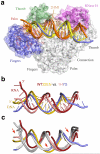Complexes of HIV-1 RT, NNRTI and RNA/DNA hybrid reveal a structure compatible with RNA degradation
- PMID: 23314251
- PMCID: PMC3973182
- DOI: 10.1038/nsmb.2485
Complexes of HIV-1 RT, NNRTI and RNA/DNA hybrid reveal a structure compatible with RNA degradation
Abstract
Hundreds of structures of type 1 human immunodeficiency virus (HIV-1) reverse transcriptase (RT) have been determined, but only one contains an RNA/DNA hybrid. Here we report three structures of HIV-1 RT complexed with a non-nucleotide RT inhibitor (NNRTI) and an RNA/DNA hybrid. In the presence of an NNRTI, the RNA/DNA structure differs from all prior nucleic acid-RT structures including the RNA/DNA hybrid. The enzyme structure also differs from all previous RT-DNA complexes. Thus, the hybrid has ready access to the RNase-H active site. These observations indicate that an RT-nucleic acid complex may adopt two structural states, one competent for DNA polymerization and the other for RNA degradation. RT mutations that confer drug resistance but are distant from the inhibitor-binding sites often map to the unique RT-hybrid interface that undergoes conformational changes between two catalytic states.
Figures






Comment in
-
Structural requirements for RNA degradation by HIV-1 reverse transcriptase.Nat Struct Mol Biol. 2013 Dec;20(12):1341-2. doi: 10.1038/nsmb.2725. Nat Struct Mol Biol. 2013. PMID: 24304910 No abstract available.
-
Reply to "Structural requirements for RNA degradation by HIV-1 reverse transcriptase".Nat Struct Mol Biol. 2013 Dec;20(12):1342-3. doi: 10.1038/nsmb.2726. Nat Struct Mol Biol. 2013. PMID: 24304911 Free PMC article. No abstract available.
References
-
- Varmus H. Reverse transcription. Sci Am. 1987;257:56–59. 62–54. - PubMed
-
- Cihlar T, Ray AS. Nucleoside and nucleotide HIV reverse transcriptase inhibitors: 25 years after zidovudine. Antiviral Res. 2010;85:39–58. - PubMed
-
- de Bethune MP. Non-nucleoside reverse transcriptase inhibitors (NNRTIs), their discovery, development, and use in the treatment of HIV-1 infection: a review of the last 20 years (1989–2009) Antiviral Res. 2010;85:75–90. - PubMed
-
- di Marzo Veronese F, et al. Characterization of highly immunogenic p66/p51 as the reverse transcriptase of HTLV-III/LAV. Science. 1986;231:1289–1291. - PubMed
Publication types
MeSH terms
Substances
Associated data
- Actions
- Actions
- Actions
Grants and funding
LinkOut - more resources
Full Text Sources
Other Literature Sources

